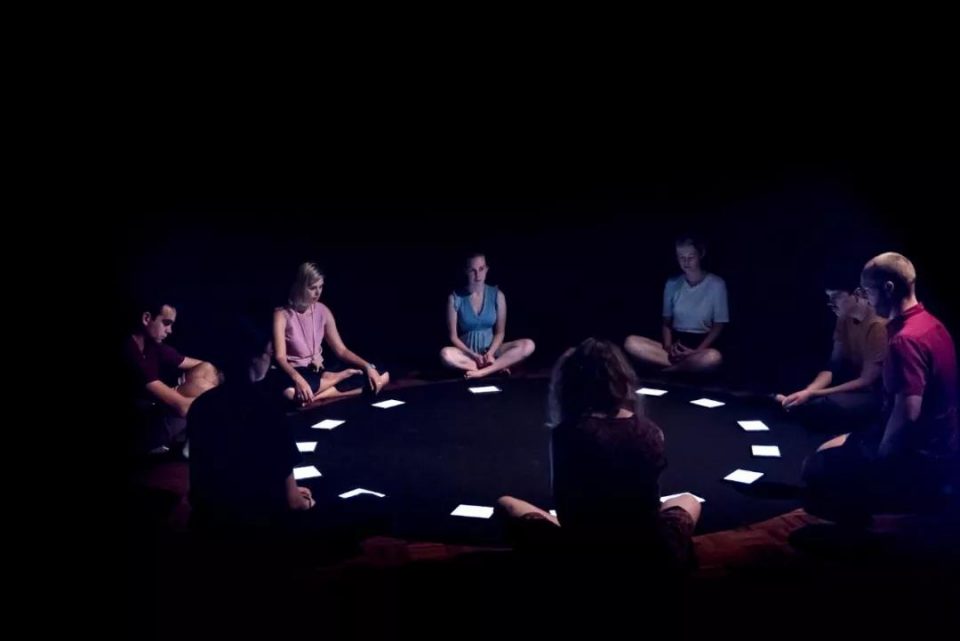Modern Dance Comes Into Its Own in China

LATW presents: Top Secret China (Video)
2月 22, 2012
现代舞在中国蓬勃 发展自己的语言
3月 8, 2012Check out the full New York Times article at this link.
Lithe, fresh-faced dancers from the Beijing Dance Theater and weathered farmer-musicians from a rural area of Shaanxi Province — costumed in worn indigo robes and carrying handmade masks on wooden sticks — shouted, whistled and leaped as shadow puppets frolicked behind a translucent screen.
The scene played out this winter in the basement of Beijing’s cavernous Olympic Badminton Center as a high-ceilinged hall was filled with the sound of clanging bells, crashing cymbals and pounding drums.
The next day, across town in a drafty second-floor practice room belonging to the Chinese Navy Club, a handful of dancers from the Beijing Modern Dance Company prepared for a New Year’s show with their director, Gaoyan Jinzi. Oblivious to the frosty air, they warmed up with calisthenics, endless stomach crunches and joyful dance moves to recorded New Age music; above their heads, the walls were emblazoned with banners that read “Preserve artistic integrity, respect the audience.”
The same day, in a spacious loft in an artists’ colony in the suburbs, Tao Ye and three female members of his TAO Dance Theater rehearsed to no music whatsoever, rolling across the floor, sticking out their left feet with each dancer rising to a knee as one. With bodies wound like springs, they repeated the sequence without rest until Mr. Tao, who performed last year in five countries on three continents, determined they had gotten it right.
As these glimpses indicate, modern dance in China is finally coming into its own after years of lagging behind other theatrical arts in performance opportunities, funding, media coverage and audience.
“The audience is growing,” said Alison Friedman, of Ping Pong Productions, which represents TAO Dance Theater. “You see more dancers staying in China. There isn’t this rush to go abroad. You even see people coming back to find and create opportunities here.”
Most remarkable of all, in a Chinese context, is that many of these companies are privately run, self-supporting, unregistered — and fiercely independent — entities that manage to survive in a nation where the government has at least nominal control over most performing arts organizations and corporate sponsorship of the arts is minimal.

‘‘Color of Love,’’ a dance choreographed by Wang Yuanyuan for the Royal Danish Ballet.
“We are independent,” said Mr. Tao proudly. “It isn’t too hard to find support. If you live a simple life and do what you love, you can do it.”
Modern dance has a relatively short history in China. Back in 1895, Yu Rongling, the daughter of imperial China’s ambassador to France, studied in Paris with Isadora Duncan. When Yu returned to China, the Empress Dowager Cixi appointed her as a sort of lady-in-waiting responsible for introducing new dances to the court. For most of the 20th century, however, the political climate was not conducive to modern dance. Instead, China built an infrastructure to support ballet, which was introduced by the Soviet Union, folk dance, and traditional opera.
American Dance Festival started a modern dance training program in Guangzhou in 1986 and the Guangdong Modern Dance Company, China’s first, was formed in 1992. Others soon followed and, according to Ms. Gaoyan, the period from 2000 to 2005 was a time of rapid development and increasing confidence.
“And then, from about 2005, we began speaking for ourselves,” she explained. “Chinese modern dance has its own language now. That’s why so many international arts festivals invite us.”
Indeed, dance companies from China have been a regular feature at global arts festivals for several years now. The Beijing Dance Theater will perform in Spain, France, Denmark and Germany later this year; Ms. Gaoyan is a guest artist at Brown University in February; and TAO Dance Theater will be featured at the Lincoln Center Festival in New York, the Gdansk Festival in Poland and the Novel Dance Festival in Taiwan.
The Shanghai-based Jin Xing Dance Theater wrapped up a two-month, multicity U.S. tour in late February and Beijing Dance/LDTX, another Beijing-based company, toured internationally in 2010. The Guangdong Modern Dance Company has produced such global talents as the choreographer Shen Wei.
The language of these dance companies is often influenced by traditional Chinese culture. Wang Yuanyuan, for instance, frequently seeks inspiration in Chinese literature — “The Book of Mountains and Sea” is based on the Nobel Prize-winning novelist Gao Xingjian’s recreation of ancient Chinese mythology — while Ms. Gaoyan cites Chan, or Zen, as a source of her choreography. Both Jin Xing Dance Theater and Beijing Dance Theater have done interpretations of the Ming Dynasty opera “The Peony Pavilion.” Indeed, most modern dance is still representational, since Chinese audiences expect stories; for “Mountains and Sea,” Beijing Dance Theater performers even had to memorize lengthy speaking parts.
“They are going for an old China aesthetic,” Ms. Friedman said. “Choreographers and artistic directors are reconstructing a past that was interrupted.”

Disciplined Members of TAO Dance Theater. Modern dance has lagged behind other arts in China.
An exception to this tendency is Mr. Tao, who says that he aims to eschew any influence from the past.
“History has been revised here, it hasn’t really been preserved,” he said. “I think the body gives you everything. It contains all possibilities. I just need to bring this out.”
But even as China’s modern dance companies have developed their own distinct voices and been welcomed abroad, they have struggled to broaden the audience base at home. Although the situation is improving, overseas tours and participation in international festivals remain the bread and butter of most dance companies, who use the fees from these to subsidize performances at home.
“We lose money every time we perform here because Chinese audiences don’t buy tickets,” Ms. Gaoyan said. “We have been around for 16 years, always depending for survival on performances outside China.”
Ms. Friedman cited some of the major issues facing modern dance: the dearth of resident dance companies; the prohibitive cost of renting performance space; the low rate of corporate donations to the arts; the inability of unregistered dance companies to apply for any government support; the emphasis on technique and rote learning in dance education; the influence of televised dance extravaganzas, to which much choreography is geared; the lack of celebrity dancers (the exception being Jin Xing); and the absence of financing for dramaturgs and workshops.
Nonetheless, China’s modern dance companies are committed to seeing their art take root at home. The Beijing Dance Theater is systematically working to bring in young audiences by performing on college campuses, creating dances that reflect their lives and collaborating with artists from popular genres like hip-hop.
Most modern dance artists also express cautious optimism that the government’s current focus on cultural development will benefit them, at least peripherally.
“The time is right,” said Ms. Gaoyan. “Performing for Westerners just to survive isn’t right. I want to do more in China in 2012. While everyone is focusing on culture, we should perform. Most Chinese audiences have never seen modern dance. We have a responsibility to show them.”




